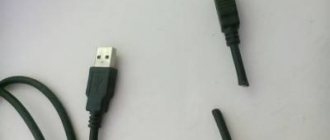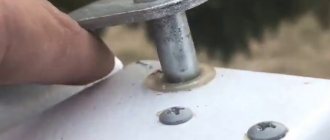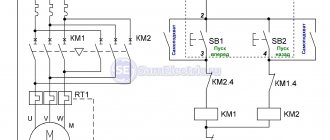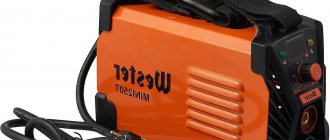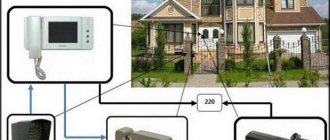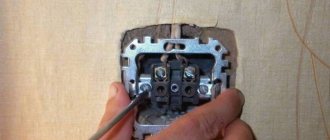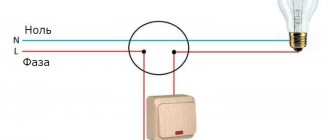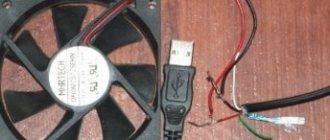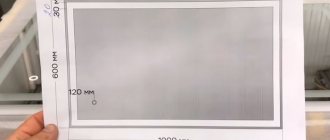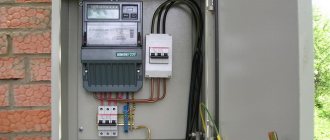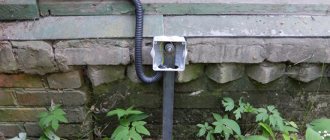You will again have problems with revs and jamming. Sometimes the cause of a breakdown is trivial and unpredictable.
We've sorted out the rear bearing, then move on to the front part of the fan. There is a protective cap in the center here.
It unscrews, attention - clockwise, since the thread here is left-handed.
You throw it off and remove the propeller from the shaft. You now have access to the front journal bearing.
The principle is the same here. First, squeeze out and soften the old grease and dirt with a Vedashka, and then apply new one.
After that, put the propeller back on and close the lid. Having completed the repair, turn on the fan at high speeds, let it run for a few minutes, and switch to the speed required.
Short circuit of windings or broken wires
If the damage is more complex and simple lubrication does not help, you will have to disassemble the fan in more detail.
First, you do all the disassembly machinations as indicated above. After removing the propeller, unscrew the plastic front lock nut, which is located immediately behind it, and remove the entire protective frame.
In your hands you still have the motor itself and the leg in which the power wires pass and the push-button mechanism is located.
You disassemble this leg by unscrewing 6 screws.
First of all, check the soldering of the wires. It is quite possible that one of them, or even several, has fallen off or burned off.
If everything is intact, how can you figure out which wire goes where and is responsible for what? Start testing with two wires from the power plug.
One of them, let it be black (as in the photo below), goes directly through the backlight to the fan motor.
The second wire goes to the lower terminal of the dial switch (button 0).
Next, by pressing the corresponding buttons - 1st speed, 2nd, 3rd, certain switch contacts are closed, and thereby the engine speed changes.
Each wire from these buttons goes to its own terminal on the winding, with a greater or lesser number of turns. By applying voltage to them, you make the propeller spin faster or slower.
Floor fan connection diagram
A simplified diagram of a wind blower looks like this.
Typical circuits for most inexpensive 3-speed floor fans are something like this:
Pressing each button is accompanied by the closure of its contact group.
In this case, the other contact group opens at this moment.
Sometimes these contacts burn out or do not reach their plate. Then you lose any of the speeds.
All this is checked simply with a Chinese multimeter, in circuit continuity mode.
If your very first wire breaks or there is no contact on it, the fan motor simply will not start. Therefore, if the fan is completely inoperative, check it first.
Unless, of course, before you make sure that the plug itself and the power cord from it are working properly. This is also caused by the tester.
Place one end of the probes on the pin of the plug, and touch the other end to the contact pad on the “0” button. If working properly, there should be zero resistance.
Then you can check the wires in the same way at all speeds. Contact probe for the plug - another probe for the outgoing wire from the corresponding speed button to the engine.
If there are zeros everywhere, then the switch and wires are working.
Next, check the second contact on the plug and the wiring that goes directly past the switch to the engine. Make sure your cord is intact here too.
Only after this can you proceed to checking the windings of the motor itself.
How to check fan windings
Set the resistance on the multimeter to 2000 ohms. Next, in order not to bite the wires anywhere, at the place where the capacitor is connected, strip off the insulation a little.
Look for the common point of the circuit, as in the diagram below.
Having found it, you call up the resistance of the winding. To do this, touch the contacts on the switch with the second probe one by one.
Approximate fan winding resistance values can be as follows:
Of course, they may differ slightly for different models, but the most important thing is that there is no breakage or short circuit. Measurements can show either several hundred Ohms or a little more than 1 kOhm.
It all depends on the power of the fan and the cross-section of the wire.
The resistance between the terminals of the windings will be lower - 100-200 Ohms.
The capacitor winding and the total resistance of all windings combined are also checked.
Here is the most competent and complete video on checking the performance of fan windings with a multimeter.
If checking the integrity of the windings also does not reveal any deviations or defects, move on. To do this, you completely disassemble the fan, as they say, piece by piece.
Engine disassembly and malfunction
First, the engine must be freed of all plastic parts. Unscrew the 4 screws from the front side and remove the cover.
On new models, in addition to screws, there are also latches. They need to be bent with a screwdriver.
To disconnect the leg, you need to find another screw, which is usually hidden under the plug.
Loosen it and pull out the mounting shaft. To dismantle the wires that pass through the leg, you will need to bite them out or unsolder them from the terminal blocks on the speed buttons.
At the same time, write down or sketch where each one is initially connected.
As a result, you should have a bare fan motor in your hands without anything unnecessary.
Let's take it apart. Unscrew the screws holding the back cover together.
At the same time, before disassembling, be sure to put marks on all covers and hardware indicating how everything was originally assembled.
Otherwise, after incorrect docking, you will lose alignment. There will be problems with the shaft wedging and the rotation of the blades.
Thermal safety relay malfunction
After removing the bearing, you get to the windings themselves. Among the bundle of power wires coming from the switch, look for a special thermal relay.
Very often the engine stops working after it burns out. This relay should operate and open the circuit at a winding temperature of 135-145 degrees.
After cooling, the relay closes again and the fan starts. So, sometimes it burns out completely and actually plays the role of a fuse.
If your fan often turns off and starts again on its own, this protection is to blame. Know that it doesn't just work. This means that your shaft is either jammed, or the windings are exhausted and they are overheating.
Overheating of the windings may be associated with the destruction of the small impeller, which is located on the shaft inside the engine itself. It is designed to blow air and reduce the temperature of the coils.
The cheapest models do not have a temperature sensor-relay; everything is connected directly. Based on this, if your “thermal fuse” has burned out, you can, of course, bypass it and start the wind blower. But at the same time you will be left without fire protection.
This relay is also checked by the tester.
There should be a chain between its legs in continuity mode.
Shaft displacement and broken turns
If all the parts and relays inside are intact, all that remains is to carefully examine the windings, shaft and rotor through a magnifying glass. You may see broken or damaged copper strands.
This happens when a bearing jumps out of its seat and the rotor begins to hit the windings.
With modern Chinese floor fans, the screw connection between the two halves of the motor quite often loosens. Do not forget that the shaft on both sides is mounted on self-centering copper-graphite bushings, which are tightly locked in the covers.
When assembling and tightening them, you can lightly tap the transformer iron itself with a hammer so that the shaft rotates easily, with little inertia. Someone tries to catch the center on their own and creates such a quiet horror.
Eventually the shaft falls out of the bearing, resulting in a wedge. As a result, the rotor begins to scratch the windings and its surface.
Also keep in mind that if your fan fell and then stopped working and rotating, then the bushings are most likely misaligned here too. Nothing else can break from such a fall.
This will not damage the capacitor, and the windings covered with varnish will not break. Perhaps some buttons may move away. But first of all, check the alignment of the bearings. And then everything will work as it should.
Unfortunately, you cannot cope with a mechanical defect in the windings or rotor, as well as their intra-turn short circuits. It is not rational to rewind the engines of cheap wind blowers; it will be much easier to buy a new model.
However, this is already the last stage of verification, and there is hope that you will never get to it, having found damage somewhere else using the methods discussed above.
Source
Share the news on social networks
- Related Posts
- 5 secrets of the KG cable - where not to connect, characteristics, differences from KOG, KGTP, KGHL, KGNG.
- Stripping insulation from jokari 15 round cables - disadvantages and advantages of the stripper
- Stripper weidmuller stripax 10, 16 - full review
« Previous entry
Using an electromagnetic relay
To drive the fan, a DC electric motor with excitation from permanent magnets ME or similar is installed.
We also do not recommend connecting the circuit so that after turning on the ignition the electric fan constantly rotates, as this significantly reduces its service life. Installation and connection of the fan Considering that cars are equipped with fans in normal mode, re-installation may only be necessary during repair work, that is, after replacing broken parts of an old part or when installing a new device.
Then, using the same key, unscrew the bolts securing the radiator tube that connects it to the air conditioning system if, of course, such is provided for by the design of the car and move it to the side. I installed a 30 pin relay in the power circuit. However, it is only in recent years that fan control technology has developed significantly. We also do not recommend connecting the circuit so that after turning on the ignition the electric fan constantly rotates, as this significantly reduces its service life. Source fornk. It is convenient to place the relay on the side surface of the body behind the right headlight, closer to the battery.
The normal operation of the cooling fan remained in place. Operating modes When understanding the operating principle and connection diagram of the radiator fan, you should remember that electric motors often have two speed modes.
Of course, there are certain limits for changing the supply voltage. Turn on the hazard lights, depress the clutch pedal and, using the inertia of the car, try to carefully move to the edge of the roadway and stop as far to the right as possible on the side of the road, and if possible, outside the roadway.
Application of semiconductors Instead of an electromagnetic relay, you can use a thyristor switch, or a design based on field-effect transistors. The block uses small connectors, female 2.8, so in order not to spoil the wire, we make an additional wire on one end, small male 2.8, on the other, female 6.3, using a block for small connectors, connect the wires to each other and connect them to the existing wires. Fan connection
Settings Features
Some products are equipped with a toilet/bathroom switch or jumper. In the first case, switching occurs simultaneously with the closure of the supply circuit. In the second, an adjustable pause is provided, sufficient for the user to leave the room.
For example, for ERA products the jumper is located on the control board in the upper corner:
MAICO has jumpers near the mode indication LEDs:
For products equipped with a hygrostat and timer, the following can be configured:
- humidity level;
- shutdown delay.
In particular, representatives of the Electrolux EAFM-TH series have: a humidity sensor with a control range of 40 - 100%, a timer with a delay that can be set from 1 to 20 minutes. Adjustment is made with a screwdriver.
If the set humidity value is lower than the actual one, the hood will turn on, even when the lighting is turned off, for this purpose voltage is constantly supplied to the board. The electric fan will continue to operate until the set humidity level is reached, regardless of the time setting or lamp shutdown. If the humidity level is set above room temperature, the device will turn off after the set time interval.
Fastening
Wall-mounted versions are normally secured with self-tapping screws at the corners of the plastic frame. Having removed the front cover, mark the centers, drill holes, and hammer in the plastic dowels from the kit.
Before fastening, insert the cable through the frame entry.
When they don’t want to drill into the tiles, they fix the frame with “liquid nails.”
Switch installation
Grooves from the distribution box must also be made to the installation site of the switch (in the case of walls made of plasterboard sheets, a corrugated pipe is used). It is necessary to lay a two-core wire in the grooves and fix it with a solution. The ends of the wire must be led out into the junction box and into the hole for the switch.
The switch is made of a working part and a protective cover with a button. A socket box must be installed in the hole. Now take the working mechanism; its contact part has two terminals for connecting wire cores. One terminal is an incoming contact; a phase conductor from the supply network is connected to it. The second terminal is the output contact; the phase from the fan will be connected to it. Make the necessary connections and check the reliability of the contact connections.
Fix the working mechanism in the socket box. Install the protective cover and put on the key.
If a switch with two keys is installed, then such a switching device has two output contacts, one of which must be connected to the fan, the second to the lighting device. Accordingly, one key starts the ventilation device, the second turns on the lighting in the bathroom.
Connection options
If the number of contacts on the cooler connector and the fan itself matches, then there is no problem. The connectors are connected to each other, non-compliance with polarity is excluded due to the presence of a key . If they do not match, then options are possible.
3-pin to 4-pin
The three- and four-pin connectors are fully compatible with each other , both electrically and mechanically. Structurally, they are designed in such a way that the key allows the connection to be made, and there will be no pinout conflict.
Connecting a 3-pin fan to a 4-pin connector.
If the cooler has a connector with 3 pins, and a harness with 4 pins comes from the computer, then the power wires are connected at the terminal, as well as the speed measurement circuits. The PWM control wire remains unconnected.
Connecting a 4-pin fan to a 3-pin connector.
If the cooler has a connector with 4 pins, and a terminal with 3 pins comes from the computer, then on the electric motor side will remain unconnected In both cases, speed control via PWM is not possible.
Connecting directly to power supply wires
In cases where automatic airflow control is not required (usually case fans), they can be powered directly from the power supply. In this case, the coolers will turn on when the power supply starts, and stop when it turns off. It is rational to make such a connection for fans with two pins (without speed control). There are no fundamental restrictions for using 3- and 4-pin coolers in this capacity, but they are more expensive.
Molex male-female adapter with a branch to the cooler.
The easiest way is to connect a two-pin fan directly to an empty Molex connector. It is more convenient to do this using a Molex male-to-female adapter with a branch for the cooler connector. If there is no free Molex in the harness from the power supply, but there is, for example, an unused SATA power terminal, you can switch from it to Molex, and then to the fan.
The number of detachable connections should be minimized. It’s even better (if you have the skills and qualifications) to cut off the terminals, and then twist the power wires together with the following soldering and insulation of the connection point.
Connecting wires
Now the following connections must be made in the junction box:
- Connect the neutral wire from the supply network to the zero wire of the fan.
- Connect the phase conductor from the supply network to the conductor that goes to the incoming contact of the switch.
- Connect the phase conductor of the fan to the conductor of the wire that comes from the output contact of the switch.
In the case of a two-key switch, the distribution box will additionally have the following connections:
- The neutral conductor from the supply network will still be connected to the neutral of the lamp.
- The phase core of the lamp must be connected to the wire core that comes from the second output contact of the switch.
As you can see, nothing complicated. Be sure to consider installing a fan in the bathroom. Nowadays they come up with a lot of fashionable electrical gadgets, but half of them are complete whims. But the ventilation of a room such as a bathroom is really not an unimportant issue. So this article is relevant and useful.
Channel check
Before connecting the fan, you need to check the condition of the ventilation shaft.
Some people recommend this method by holding a sheet of thin paper to the vent. It should be attracted if the hood is good. But it’s more reliable to check with a flame, using matches or a candle. Light a candle and bring it to the hole, the flame should seem to stretch towards the channel. If this does not happen and the flame is even, it means that the ventilation duct is clogged and requires cleaning. To do this, you need to contact special housing and communal services.
Search on the site
Using a size 8 wrench, unscrew the air intake mount and remove it. This is exactly the connection option on my Gazelle.
Therefore, if you have a need for any other option not described below, write to me at trs mail.
The fan can be connected in several ways: for example, through the ignition switch or through the coolant temperature sensor.
When using two similar fans, this scheme does not provide any gain in cooling efficiency. Scheme for switching on the cooling fan of an injection engine.
Read additionally: Which specialists conduct energy audits?
AUTO ELECTRICIAN
The circuit for switching on the cooling fan of a VAZ with an injection engine is powered by an electronic engine control controller. And next to it hangs a blue wire with a flat chip, on which nothing is ringing either. I have a suspicion that someone before me messed around with the wiring. The presence of several temperature control channels provides quite wide possibilities for designing a cooling system.
Also a simple circuit on one relay. Disconnect the wire block on the fan connector. So we are content with what we have.
Post navigation
Let's consider not only the operating principle, but also the connection option with the possibility of forced activation of the VCO cooling system fan. If you have an old-style radiator, or a Luzarovsky universal one, then you do not need to cut the pipe. Scheme for switching on the cooling fan of an injection engine. It fits the thread, but it has a different feature.
Scheme 1. Despite the importance of such a device, it has a fairly simple design and usually consists of three main elements: the impeller usually has four blades, but there may be more, a casing and a fan drive. However, I note that in hot weather they did not turn off at all. How to wire a VAZ 2109 cooling fan. The simplest diagram.
How much does the sensor cost?
The cost of the sensor depends on its type and car brand.
| Name | Price, rub |
| Bimetallic for domestic cars | from 250 to 400 |
| Sensor for budget foreign cars | from 700 to 1500 |
| Prices are relevant for three regions: Moscow, Chelyabinsk, Krasnodar | |
The cost of sensors for some types of vehicles can reach up to 3-6 thousand rubles.
Fan troubleshooting and troubleshooting
To reduce costs and achieve low noise levels during operation, plain bearings are installed in fan motors. As a result, after a couple of years of operation, the lubricant is exhausted, and this is the most common cause of fan failures.
| Table of fan malfunctions and recommendations for their repair | |||
| External manifestation of the malfunction | Possible cause of malfunction | Troubleshooting | Repair method |
| The fan turns off after some time after normal operation and turns on again after a while | A self-resetting thermal fuse against overheating of the windings is triggered | Check the freedom of rotation of the impeller, disassemble the fan and inspect the stator windings for blackening | Lubricate the bearings, rewind the winding |
| The fan turns on, but the blades rotate slowly | The grease in the electric motor bearings has thickened or run out | If the bearings are insufficiently lubricated during operation, the fan produces increased acoustic noise and a burning smell may appear due to overheating of the motor windings | It is necessary to disassemble the fan and lubricate the sliding bearings with machine oil. |
| Mechanical wear of electric motor bearings due to lack of lubrication. In this case, vibration of the impeller relative to the center of rotation is often observed | Rock the impeller to the sides relative to the center. If the play is more than 0.5 mm, then the bearing is worn out | Replace the bearing with a new one | |
| The fan does not start, the blades do not rotate | The cord is not plugged into the outlet | Check | Insert the cord plug into the socket |
| No voltage at the socket | Check the presence of voltage in the outlet using a working electrical appliance | Connect the fan to a working outlet | |
| The power cord is faulty | Visually check the plug and cord for mechanical damage, check the integrity of the cord wires with a multimeter | If faulty, replace the power plug or cord | |
| The switch or speed switch is faulty. The battery in the remote control is low | It is necessary to open the Fan and test the switch with a multimeter. When in the on position, the resistance between the switch contacts should be zero | If the switch is faulty, replace it. If you don’t have it at hand, you can short-circuit the contacts of the switch and turn off the fan by removing the plug from the socket | |
| The fan hums and gets hot when turned on. | The rotor shaft is jammed due to depletion or thickening of the lubricant | Disassemble the fan, wash with solvent and lubricate the bearings | |
| The fan hums and gets hot when turned on. | Break in the starting winding or capacitor. | Turn the impeller by hand, if it rotates, then replace the capacitor or try to find the break point of the starting winding | |
| Broken rotor windings | Visually check the windings for mechanical damage and local darkening, check the integrity of the windings with a multimeter | If a break in the winding cannot be found by external inspection, then it will have to be rewinded, which is not economically feasible. | |
| The thermal fuse against overheating of the electric motor has tripped due to its malfunction | Check the integrity of the thermal fuse with a multimeter. Its resistance should be zero. To check in the absence of the device, you can temporarily short-circuit its terminals | If a broken thermal fuse is detected, replace it with a serviceable one. If the new thermal fuse blows again when the fan is running for a short time, then the electric motor is faulty | |
For reliable operation of the fan, it is recommended to disassemble it and lubricate the bearings with machine oil before each season of operation. But no one does this, including me. Usually, lubrication is done when the blades stop rotating or the fan begins to make a lot of noise.
Advantages
The bathroom is a room with high humidity. And excess moisture leads to the appearance of fungi and mold, various unpleasant insects such as centipedes and woodlice. If the bathroom is large, it can be equipped with various furniture (cabinets and shelves), and high humidity causes delamination of materials. Also in bathrooms there are metal structures (towel rails, towel and toilet paper holders), moisture accelerates their rusting.
Also, humidity is often accompanied by an unpleasant smell of dampness. And it’s even worse when the neighbors downstairs smoke in the bathroom, and the ventilation duct brings these odors to you.
Condensation also constantly collects on mirrors and walls, which can lead to premature destruction of the tiles.
Natural ventilation does not always cope with humidity and “odors” in the bathroom; sometimes it is further enhanced with the help of exhaust systems. One of these options is a fan.
